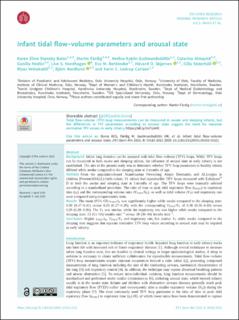| dc.contributor.author | Bains, Karen Eline Stensby | |
| dc.contributor.author | Färdig, Martin | |
| dc.contributor.author | Gudmundsdottir, Hrefna Katrin | |
| dc.contributor.author | Almqvist, Catarina | |
| dc.contributor.author | Hedlin, Gunilla | |
| dc.contributor.author | Nordhagen, Live Solveig | |
| dc.contributor.author | Rehbinder, Eva Maria | |
| dc.contributor.author | Skjerven, Håvard Ove | |
| dc.contributor.author | Vettukattil, Cilla Söderhäll Riyas | |
| dc.contributor.author | Nordlund, Bjørn Kristian | |
| dc.contributor.author | Carlsen, Karin Cecilie Lødrup | |
| dc.date.accessioned | 2023-02-20T12:12:21Z | |
| dc.date.available | 2023-02-20T12:12:21Z | |
| dc.date.created | 2022-11-02T05:54:45Z | |
| dc.date.issued | 2022 | |
| dc.identifier.citation | European Respiratory Journal Open Research (ERJ Open Research). 2022, 8 (4), 1-8. | en_US |
| dc.identifier.issn | 2312-0541 | |
| dc.identifier.uri | https://hdl.handle.net/11250/3052350 | |
| dc.description | This version is distributed under the terms of the Creative Commons Attribution NonCommercial Licence 4.0. For commercial reproduction rights and permissions contact: permissions@ersnet.org | en_US |
| dc.description.abstract | Background: Infant lung function can be assessed with tidal flow–volume (TFV) loops. While TFV loops can be measured in both awake and sleeping infants, the influence of arousal state in early infancy is not established. The aim of the present study was to determine whether TFV loop parameters in healthy infants differed while awake compared to the sleeping state at 3 months of age.
Methods: From the population-based Scandinavian Preventing Atopic Dermatitis and ALLergies in children (PreventADALL) birth cohort, 91 infants had reproducible TFV loops measured with Exhalyzer® D in both the awake and sleeping state at 3 months of age. The TFV loops were manually selected according to a standardised procedure. The ratio of time to peak tidal expiratory flow (tPTEF) to expiratory time (tE) and the corresponding volume ratio (VPTEF/VE), as well as tidal volume (VT) and respiratory rate were compared using nonparametric tests.
Results: The mean (95% CI) tPTEF/tE was significantly higher while awake compared to the sleeping state: 0.39 (0.37–0.41) versus 0.28 (0.27–0.29); with the corresponding VPTEF/VE of 0.38 (0.36–0.40) versus 0.29 (0.28–0.30). The VT was similar, while the respiratory rate was higher while awake compared to the sleeping state: 53 (51–56) breaths·min−1 versus 38 (36–40) breaths·min−1 .
Conclusion: Higher tPTEF/tE, VPTEF/VE and respiratory rate, but similar VT while awake compared to the sleeping state suggests that separate normative TFV loop values according to arousal state may be required in early infancy. | en_US |
| dc.language.iso | eng | en_US |
| dc.publisher | European Respiratory Society | en_US |
| dc.rights | Navngivelse-Ikkekommersiell 4.0 Internasjonal | * |
| dc.rights.uri | http://creativecommons.org/licenses/by-nc/4.0/deed.no | * |
| dc.subject | sleep medicine | en_US |
| dc.subject | paediatric pulmonology | en_US |
| dc.subject | lung structure and function | en_US |
| dc.title | Infant tidal flow–volume parameters and arousal state | en_US |
| dc.type | Peer reviewed | en_US |
| dc.type | Journal article | en_US |
| dc.description.version | publishedVersion | en_US |
| dc.rights.holder | ©The authors 2022 | en_US |
| dc.source.pagenumber | 1-8 | en_US |
| dc.source.volume | 8 | en_US |
| dc.source.journal | European Respiratory Journal Open Research (ERJ Open Research) | en_US |
| dc.source.issue | 4 | en_US |
| dc.identifier.doi | 10.1183/23120541.00163-2022 | |
| dc.identifier.cristin | 2067658 | |
| cristin.ispublished | true | |
| cristin.fulltext | original | |
| cristin.qualitycode | 1 | |

